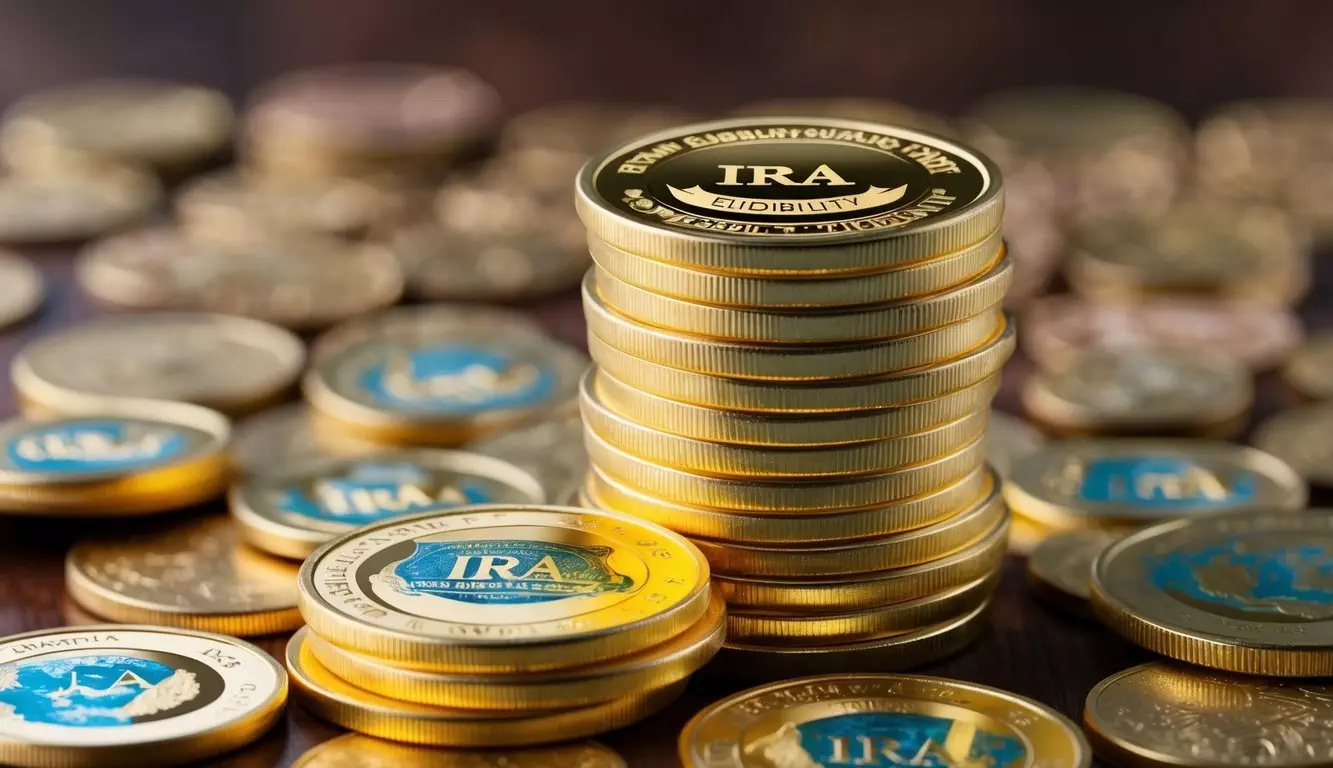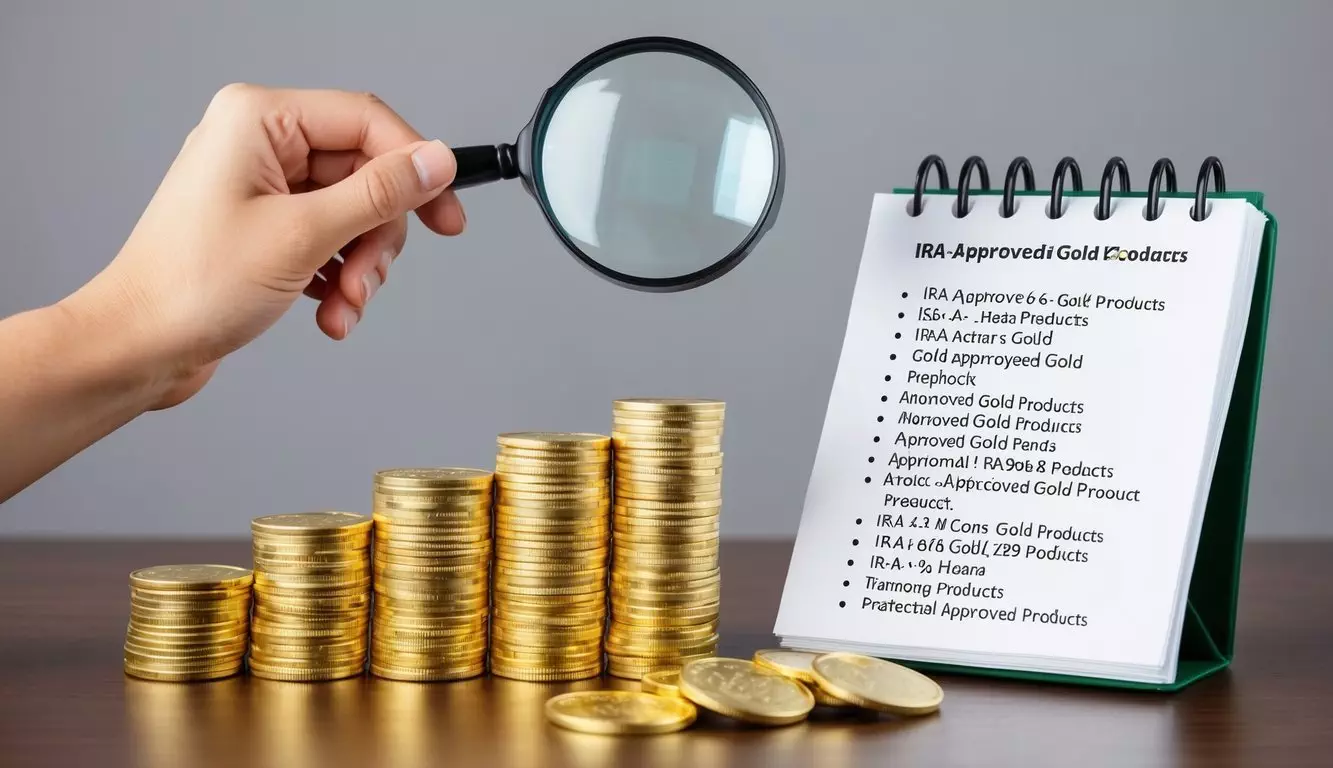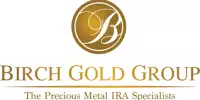Looking to add gold coins to your retirement plan? IRA eligible gold coins might be the answer. These special coins let you invest in physical gold through your Individual Retirement Account.

Not all gold coins qualify for an IRA, as they must meet specific purity standards set by the IRS and be stored in an approved depository. Popular options include American Gold Eagles, Canadian Gold Maple Leafs, and Austrian Gold Philharmonics.
A Self-Directed IRA is necessary for holding precious metals, giving you more control over your retirement investments. Many investors choose this path to diversify their retirement savings beyond traditional stocks and bonds, potentially providing a hedge against inflation and economic uncertainty.
Understanding IRA-Eligible Gold Coins

Investing in precious metals through an IRA requires following specific IRS guidelines about which gold coins qualify. Not all gold coins can be included in your retirement account, as the IRS maintains strict standards regarding purity and authenticity.
The Basics of IRA-Eligible Precious Metals
A Self-Directed Individual Retirement Account (SDIRA) allows investors to hold alternative assets like precious metals. Unlike traditional IRAs that typically contain stocks and bonds, a Gold IRA specifically holds physical gold and other approved precious metals.
These specialized accounts must be managed by an IRS-approved custodian. The custodian handles all transactions and ensures the physical gold is stored in an approved depository.
Gold IRAs follow the same contribution limits and tax advantages as traditional IRAs. For 2025, individuals under 50 can contribute up to $7,000, while those over 50 can contribute $8,000.
The primary benefit of gold in an IRA is portfolio diversification. Gold often moves independently from stock markets, potentially providing stability during economic uncertainty.
Defining IRA-Eligible Gold
IRA-eligible gold must meet specific criteria set by the Internal Revenue Service. These requirements ensure the gold maintains its value and liquidity.
The IRS only permits certain forms of gold in retirement accounts:
- Gold bullion coins issued by approved government mints
- Gold bars from approved refiners
- Proof coins with proper certification
Not eligible for IRAs:
- Collectible coins
- Rare or numismatic coins
- Gold jewelry
- Gold with artistic value
Gold must be stored in an IRS-approved depository. You cannot personally possess IRA gold – doing so counts as a distribution and may trigger taxes and penalties.
IRS Purity Standards and Requirements
The IRS mandates strict purity standards for gold held in IRAs. Gold coins and bars must be at least 99.5% pure (24 karat) with one notable exception.
The American Gold Eagle coin is allowed despite being only 91.67% pure (22 karat). This exception exists because it’s a U.S. government-issued coin specifically authorized for IRAs.
All IRA-eligible gold must be:
- Uncirculated and in excellent condition
- Free from damage that would reduce its value
- Produced by an accredited refiner or government mint
The IRS prohibits “collectible” status gold. The value must come from the metal content, not rarity or historical significance.
Common IRA-Eligible Gold Coins
Several government-minted gold coins meet IRA requirements and are popular choices for retirement investors.
American Gold Eagle: The only 22-karat coin allowed in IRAs. Available in 1 oz, 1/2 oz, 1/4 oz, and 1/10 oz sizes. Features Lady Liberty on the obverse and an eagle on the reverse.
Canadian Gold Maple Leaf: Contains 99.99% pure gold, exceeding IRS requirements. Displays Queen Elizabeth II on one side and a maple leaf on the reverse.
Austrian Gold Philharmonic: 99.99% pure and features Vienna Philharmonic instruments on the reverse.
Australian Kangaroo/Nugget: Contains 99.99% pure gold with annually changing kangaroo designs.
These coins are widely recognized, making them liquid assets that can be easily valued and sold when needed.
Investment Relevance of Gold in Retirement Portfolios

Gold serves as a strategic asset in retirement planning, offering protection against economic uncertainty and portfolio volatility. Its historical performance during market downturns makes it a consideration for those approaching retirement age.
Gold IRAs and Retirement Diversification
Gold IRAs represent a specialized retirement account that holds physical precious metals instead of traditional paper assets. These accounts follow the same tax advantages as conventional IRAs while allowing investors to own IRA eligible gold coins and bullion.
Diversification remains a cornerstone of retirement planning. By adding gold to a portfolio traditionally filled with stocks and bonds, investors create a buffer against market correlation risk.
A properly diversified retirement portfolio typically contains:
- Stocks (growth potential)
- Bonds (income generation)
- Cash (liquidity)
- Gold (wealth preservation)
Financial advisors often recommend a 5-15% allocation to precious metals, depending on an investor’s risk tolerance and time horizon.
Market Volatility and Gold Investments
Gold has historically demonstrated an inverse relationship with stock market performance. During periods of market stress, physical gold often maintains or increases in value while other assets decline.
The 2008 financial crisis offers a clear example. While the S&P 500 fell approximately 38%, gold prices rose by 5.5%. Similarly, during the COVID-19 market crash of March 2020, gold maintained relative stability compared to equity markets.
This counter-cyclical behavior makes gold valuable for retirees who cannot afford significant portfolio drawdowns. For those living on fixed incomes, protecting against market volatility becomes especially important.
Gold’s limited correlation with traditional financial assets creates a smoothing effect on overall portfolio performance.
Gold’s Role in Long-Term Wealth Preservation
Physical gold has maintained value across centuries, serving as a hedge against inflation and currency devaluation. Unlike paper currency, gold cannot be printed at will by central banks.
Since 1971 when the gold standard ended, the purchasing power of the dollar has declined significantly. One dollar in 1971 would be worth less than 15 cents today. During this same period, gold has appreciated from $35 per ounce to over $1,800.
For retirement planning, this wealth preservation aspect becomes crucial. Retirees must ensure their savings maintain purchasing power throughout a retirement that could last 20-30 years.
Gold’s limited supply and universal recognition make it an enduring store of value that transcends economic systems and political changes.
Selecting IRA-Approved Gold Products

Choosing the right gold products for your IRA requires understanding specific eligibility requirements and working with reputable custodians who offer secure storage solutions.
Criteria for IRA-Eligible Gold Coins and Bars
IRA-eligible gold must meet strict purity standards set by the IRS. All gold coins and bars must have a minimum fineness of 99.5% (24 karat) to qualify for inclusion in an IRA.
Common IRA-approved gold coins include:
- American Gold Eagle coins
- Canadian Gold Maple Leaf coins
- Austrian Gold Philharmonic coins
- Australian Kangaroo/Nugget coins
Eligible gold bars must be produced by COMEX or NYMEX-approved refiners like Credit Suisse and Valcambi. These bars typically come in weights ranging from 1 oz to 1 kg.
The gold products must remain in their original mint packaging and come with proper authentication certificates. Collectible or numismatic coins with premium values above their metal content are not eligible for IRAs.
Reviewing Gold IRA Custodian and Storage Options
A qualified IRA custodian is essential for managing physical precious metals in a retirement account. These specialized financial institutions handle the purchasing, selling, and storage of gold assets.
IRS regulations require that IRA gold be stored in an approved depository—not in a personal safe or home storage. Depositories offer either:
- Segregated storage: Your gold is kept separate from other investors’ metals
- Non-segregated storage: Your gold is stored alongside other investors’ identical products
Storage fees typically range from 0.5% to 1% of asset value annually. Leading custodians often partner with major depositories like Brink’s or Delaware Depository Service Company.
Insurance coverage for stored metals should be verified before selecting a custodian. Most reputable facilities maintain full insurance against theft, damage, or loss.
Assessing Various Gold IRA Companies
When evaluating gold IRA companies, investors should consider several key factors:
Fee structure transparency is critical. Companies should clearly disclose all costs including:
- Setup fees
- Annual maintenance fees
- Storage costs
- Buy/sell spreads
Customer service quality can be assessed through independent review sites like Trustpilot and the Better Business Bureau. Look for companies with high ratings and positive customer feedback regarding responsive service.
Educational resources indicate a company’s commitment to informed investing. The best providers offer comprehensive learning materials about physical precious metals investing.
Industry affiliations matter. Reputable companies maintain memberships with organizations like the American Numismatic Association and Professional Coin Grading Service.
Buyback programs should be evaluated, as they determine how easily investors can liquidate their gold assets when needed.
The Process of Acquiring IRA-Eligible Gold Coins

Adding gold coins to your retirement portfolio requires following specific procedures to maintain tax advantages. The process involves setting up the right kind of account, transferring funds properly, and ensuring compliance with IRS regulations.
Steps to Open a Self-Directed Precious Metals IRA
First, select a reputable custodian that specializes in precious metals IRAs. These custodians differ from traditional financial institutions since they allow alternative assets like gold coins.
Compare fees, services, and reputation of various Gold IRA companies before making your selection. Some established companies offer comprehensive support throughout the setup process.
Complete the necessary paperwork to establish your self-directed IRA. This typically includes application forms, transfer requests, and investment direction forms.
Fund your new account either through a contribution (subject to annual limits) or a rollover from an existing retirement account like a Traditional IRA or Roth IRA.
Select IRA-eligible gold coins from the custodian’s approved list. Remember that not all gold coins qualify—they must meet specific purity standards outlined in IRS Publication 590-A.
Conducting a Rollover to a Precious Metals IRA
Direct rollovers are generally recommended to avoid potential tax issues. Your current retirement plan administrator transfers funds directly to your new gold IRA custodian without you handling the money.
Alternatively, you can use the 60-day rollover method. This allows you to withdraw funds from your existing retirement account and deposit them into your gold IRA within 60 days to avoid taxes and penalties.
Be aware of potential rollover limits. The IRS generally permits only one rollover per 12-month period across all your IRAs.
After the rollover completes, work with your custodian to select and purchase IRA-eligible gold coins. Your custodian will arrange for the secure storage of these assets in an approved depository.
Maintaining IRS Compliance for Gold IRA Investments
All precious metals must be stored in an IRS-approved depository—not in your personal possession. Your custodian will arrange this secure storage.
Pay attention to annual account maintenance fees, storage fees, and insurance costs. These expenses are typically higher for precious metals IRAs than traditional retirement accounts.
Complete required minimum distributions (RMDs) when you reach age 72 for Traditional IRAs. This may involve liquidating a portion of your gold holdings or taking distributions in-kind.
File Form 5498 annually to report the fair market value of your IRA assets to the IRS. Your custodian typically handles this reporting for you.
Review your investment periodically to ensure it aligns with your retirement goals. Consider diversifying with other precious metals like silver or approved palladium coins.
Alternatives and Complementary Gold Investments

While IRA-eligible gold coins offer tax advantages, investors have several other ways to add gold to their portfolios. These alternatives can serve different investment goals and risk tolerances.
Numismatic and Collectible Coins in IRAs
Collectible coins generally cannot be held in IRAs due to IRS regulations. These coins are valued for their rarity, condition, and historical significance rather than just their gold content.
The IRS specifically prohibits “collectibles” in IRAs, which includes most numismatic coins. The premium for these coins often exceeds 15% above their metal value, making them ineligible.
Some investors maintain separate non-IRA portfolios for numismatic coins. These collections can appreciate differently than bullion, sometimes outperforming during certain market conditions.
Collectors typically focus on coins graded by professional services like PCGS or NGC. Authenticity and condition significantly impact value, creating a different risk-reward profile than standard bullion investments.
Investing in Gold Bullion Beyond IRA Eligibility
Gold bullion products that don’t meet IRA requirements can still be valuable additions to a personal portfolio. These include foreign coins below 99.5% purity and various gold bars and rounds.
Popular non-IRA eligible options include British Sovereigns, French Napoleons, and older American gold coins. These often carry smaller premiums than modern bullion coins, potentially offering better value.
Private storage options give investors more flexibility than IRA-required depositories. Home safes, bank safe deposit boxes, and private vaulting services are common alternatives.
When purchasing non-IRA gold, investors should still verify authenticity. Reputable dealers provide assay certificates and proper documentation for bullion products.
Diversifying with Gold Mining Stocks and Funds
Gold mining stocks offer exposure to gold prices while potentially providing dividends. These companies can outperform physical gold during bull markets due to operational leverage.
ETFs like GDX (major miners) and GDXJ (junior miners) allow investors to own a basket of mining companies. This reduces the risk of selecting individual stocks while maintaining sector exposure.
Mining stocks carry additional risks beyond gold price movements. These include management decisions, production costs, geopolitical factors, and company-specific issues.
Royalty and streaming companies like Franco-Nevada and Wheaton Precious Metals offer a middle ground. They finance mining operations in exchange for a percentage of future production, often providing more stable returns than pure miners.
Gold ETFs that hold physical metal, such as SPDR Gold Shares (GLD), offer another alternative that can be held in traditional IRAs and brokerage accounts with easier liquidity than physical metals.
Special Considerations for Precious Metals IRAs

Investing in precious metals through an IRA requires attention to specific rules and requirements that differ from traditional retirement accounts. These specialized accounts have unique tax implications, strict purity standards, and offer several metal options beyond gold.
Tax Implications and Advantages of Gold IRAs
Precious Metals IRAs offer similar tax benefits to traditional IRAs but with the security of physical assets. Contributions to traditional Gold IRAs may be tax-deductible, while Roth Gold IRAs provide tax-free growth and qualified withdrawals.
These accounts require a custodian to handle the administrative duties and secure storage of metals. The IRS prohibits keeping IRA-eligible gold at home – all metals must be stored in approved depositories.
Annual contribution limits match those of standard IRAs ($7,000 for 2024, with an additional $1,000 for those 50 and older). Investors should be aware of potential early withdrawal penalties of 10% if funds are accessed before age 59½.
Understanding Fineness Requirements for IRA Metals
The IRS maintains strict purity standards for metals held in retirement accounts. Gold must meet a minimum fineness of 99.5% (.995) purity to qualify for IRA inclusion.
Silver requires 99.9% (.999) purity, while platinum and palladium must reach 99.95% (.9995) purity. These standards ensure investment-grade quality.
IRA-Eligible Gold Coins include:
- American Gold Eagles
- Canadian Gold Maple Leafs
- Australian Kangaroo/Nugget
- American Gold Buffalo
Not all gold products qualify. Collectible or rare coins, regardless of gold content, are typically excluded from IRAs. Proof coins must meet the same fineness requirements as bullion to qualify.
Evaluating Palladium and Platinum Options
Palladium and platinum provide valuable diversification within Precious Metals IRAs. These metals often follow different market patterns than gold and silver, potentially reducing overall portfolio volatility.
IRA-approved platinum and palladium options include:
- American Platinum Eagle coins
- Canadian Platinum Maple Leaf coins
- Credit Suisse Palladium Bars
- Pamp Suisse Palladium Bars
Palladium has shown strong performance in recent years due to industrial demand, particularly from the automotive sector. The metal’s relative scarcity adds to its investment appeal.
Investors should compare premium costs, as platinum and palladium products often carry higher markups over spot prices than gold. Liquidity considerations are also important when selecting these alternative precious metals.
Maintaining and Updating Your Gold IRA

Proper management of your gold IRA requires regular attention to reporting requirements, distribution rules, and portfolio adjustments to maximize retirement benefits.
Annual Reporting and IRA Valuations
Self-Directed IRAs holding physical gold require yearly valuations for IRS reporting purposes. Custodians typically handle these valuations by December 31st each year, determining the fair market value of your IRA-eligible gold coins and other precious metals.
The IRS mandates Form 5498 be filed annually to report IRA contributions and fair market values. This form is submitted by your custodian, but you should verify the reported amounts match your records.
Gold values fluctuate constantly, making accurate recordkeeping essential. Keep documentation of all purchases, including:
- Coin type and quantity
- Purchase date
- Premium paid over spot price
- Certificate of authenticity
Many custodians offer online portals where investors can track their precious metals holdings in real-time. Regular review of these statements helps ensure accuracy and proper asset allocation.
Gold IRA distributions follow the same rules as traditional IRAs. Required Minimum Distributions (RMDs) begin at age 72, calculated based on the account’s total value and your life expectancy.
When taking distributions from a gold IRA, investors have two options:
- Physical possession: Receive the actual gold coins (taxable event)
- Liquidation: Convert metals to cash before distribution
Early withdrawals before age 59½ incur a 10% penalty plus ordinary income tax. However, certain exceptions exist, including first-time home purchases and qualified education expenses.
The IRS treats gold as collectibles, potentially subjecting distributions to a maximum 28% capital gains rate rather than ordinary income rates. Consulting with a tax professional helps navigate these complex rules.
Strategies for Optimizing Your Retirement Portfolio
Gold serves as a valuable diversification tool within a balanced retirement strategy. Many financial advisors recommend maintaining 5-15% of retirement assets in precious metals.
Rebalancing schedule: Review your gold allocation quarterly or semi-annually. Market movements may increase or decrease your precious metals percentage beyond intended levels.
Consider these portfolio optimization approaches:
| Strategy | Description | Benefit |
|---|---|---|
| Dollar-cost averaging | Regular gold purchases regardless of price | Reduces timing risk |
| Barbell approach | Combining gold with growth investments | Balances stability and growth |
| Crisis hedging | Increasing allocation during uncertainty | Provides downside protection |
Economic conditions warrant different gold allocations. During inflationary periods or financial instability, investors might increase their precious metals holdings.
Tax-loss harvesting can improve returns by strategically selling underperforming coins and reinvesting in similar but not identical options.
Frequently Asked Questions

Gold IRAs have specific rules about what coins qualify and how to invest in them properly. These common questions address eligibility requirements, approved coins, selection factors, purchase methods, tax implications, and rollover procedures.
What are the criteria for gold coins to be eligible for an IRA?
IRA-eligible gold coins must meet specific fineness standards set by the IRS. The minimum purity requirement is 99.5% (0.995) for gold coins.
The coins must be produced by a national government mint or an accredited refiner. They cannot be considered collectibles or rare coins.
The coins must be in uncirculated condition and come with a certificate of authenticity. Common examples include American Gold Eagles, Canadian Gold Maple Leafs, and Austrian Gold Philharmonics.
How can you list the gold coins that are approved for inclusion in an IRA?
American Gold Eagles (all weights) are approved despite being only 91.67% pure gold due to a special exemption. Canadian Gold Maple Leafs (99.99% pure) are also IRA-eligible.
Australian Kangaroos/Nuggets (99.99% pure) and Austrian Gold Philharmonics (99.99% pure) qualify for IRAs. Other options include American Gold Buffalos (99.99% pure) and British Gold Britannias (99.99% pure).
Chinese Gold Pandas and South African Krugerrands produced after 2017 that meet purity standards can also be included. Always verify a coin’s eligibility with your IRA custodian before purchasing.
What factors should be considered when choosing gold coins for an IRA investment?
Premium over spot price is crucial as higher premiums reduce overall investment value. Some coins like American Gold Eagles command higher premiums than others.
Liquidity matters for eventual selling ease. Popular coins like Maple Leafs and Eagles typically have better liquidity than obscure ones.
Storage fees vary based on coin size and weight. Smaller denomination coins take up more space per ounce than larger ones, potentially increasing storage costs.
Can you buy gold coins directly through an IRA, and if so, how?
Direct purchases are not allowed. You must first establish a self-directed IRA with a custodian that specializes in precious metals.
After funding your account, you select coins from an approved dealer. The custodian handles the purchase transaction using your IRA funds.
The coins must be shipped directly to an IRS-approved depository, not to you personally. Taking physical possession of the coins would constitute a distribution and trigger taxes and penalties.
What are the tax implications of investing in gold within an IRA?
Gold IRAs offer the same tax advantages as traditional or Roth IRAs. With traditional gold IRAs, contributions may be tax-deductible, and growth is tax-deferred until withdrawal.
Roth gold IRAs use after-tax contributions but offer tax-free growth and qualified withdrawals. Required minimum distributions (RMDs) apply to traditional gold IRAs when you reach age 73.
Early withdrawals before age 59½ typically incur a 10% penalty plus applicable taxes. The physical gold itself isn’t taxed while held within the IRA structure.
How does one roll over existing IRA funds into a gold IRA without incurring penalties?
Direct rollovers are the safest method. Your existing IRA custodian transfers funds directly to your new gold IRA custodian without you handling the money.
The 60-day rollover rule applies if you receive the funds personally. You must deposit the entire amount into the new gold IRA within 60 days to avoid taxes and penalties.
IRS rules limit indirect rollovers to once per 12-month period across all IRAs. There’s no limit on direct trustee-to-trustee transfers, making them more flexible for investors.



